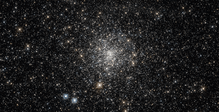NGC 6453
NGC 6453 is a globular cluster approximately 37,000 light-years away from Earth in the constellation of Scorpius.[3][2]
| NGC 6453 | |
|---|---|
 NGC 6453 (NASA/ESA HST) | |
| Observation data (J2000 epoch) | |
| Class | IV [1] |
| Constellation | Scorpius |
| Right ascension | 17h 50m 51.71s [2] |
| Declination | −34° 35′ 59.60″ [2] |
| Distance | 37.8 kly (11.6 kpc) [1][3] |
| Apparent magnitude (V) | 10.10 [1] |
| Apparent dimensions (V) | 21.5′[1] |
| Physical characteristics | |
| Mass | 169,000 [3] M☉ |
| Metallicity | = –1.50 [3] dex |
| Other designations | ESO 393-SC 036, GC 5878, h 3707[4] |
The cluster is located approximately 1 kpc (~3,260 light-years) from the Galactic center,[5] which results in confounded view of the cluster from the Solar System due to many intervening clouds of cosmic dust.[6]
The cluster measures nearly 8' across, and its brightest stars are no brighter than 14th magnitude.[6]
Observational history
NGC 6453 was discovered by John Herschel on June 8, 1837,[7][1][6] while he was observing from the Cape of Good Hope in South Africa.[8] He included the cluster as "h 3708" in his 1864 Catalogue of Nebulae and Clusters of Stars, and Danish-Irish astronomer John Dreyer later added the cluster to his New General Catalogue as object number 6453.[6] Dreyer described the cluster as "considerably large, irregularly round, pretty much brighter (in the) middle, round".[6]
See also
- Globular cluster
- List of NGC objects (6001–7000)
- Scorpius (constellation)
References
- "SEDS". spider.seds.org. Retrieved December 5, 2017.
- "NASA/IPAC Extragalactic Database". ned.ipac.caltech.edu. Retrieved December 5, 2017.
- Boyles, J.; et al. (November 2011), "Young Radio Pulsars in Galactic Globular Clusters", The Astrophysical Journal, 742 (1): 51, arXiv:1108.4402, Bibcode:2011ApJ...742...51B, doi:10.1088/0004-637X/742/1/51.
- "New General Catalog Objects: NGC 6450 - 6499". cseligman.com. Retrieved 2017-12-08.
- Ortolani, S.; Bica, E.; Barbuy, B. (1999), "Blue horizontal branch globular clusters towards the bulge: Terzan 9, NGC 6139 and NGC 6453", Astronomy and Astrophysics Supplement Series, 138 (2): 267–273, Bibcode:1999A&AS..138..267O, doi:10.1051/aas:1999275
- Harrington, Philip S. (2010). "Medium-scope challenges". Cosmic Challenge: The Ultimate Observing List for Amateurs. Cambridge University Press. p. 241.
- "Data for NGC 6453". www.astronomy-mall.com. Retrieved December 9, 2017.
- "Universe Today". www.universetoday.com. Retrieved December 5, 2017.
External links
| Wikimedia Commons has media related to NGC 6453. |
- NGC 6453 on WikiSky: DSS2, SDSS, GALEX, IRAS, Hydrogen α, X-Ray, Astrophoto, Sky Map, Articles and images
- SEDS